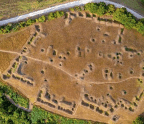
This jersey, a precious object at Palmerston North’s Rugby Museum, has many threads – male culture, the evolution of rugby and the development of New Zealand nationalism under Richard Seddon. But let’s start at an unexpected place, the history of women.
It was women who sewed this striking woollen jersey in the factory of J Stubbs Hosiery of Palmerston North. This business began after Mary Alice Stubbs and her husband John migrated from England in 1880. While John tried farming, the couple imported a Griswold hand-operated sock-knitting machine in 1884, initially for the family’s needs. The socks became popular and soon Mary Alice had a thriving cottage industry. In 1889, they recognised the opportunity and the family opened a business as a hosiery manufacturer. In 1905, to attract more women employees, they moved to Wellington and won a contract to supply jerseys for the New Zealand rugby team.
Sewing clothes in






